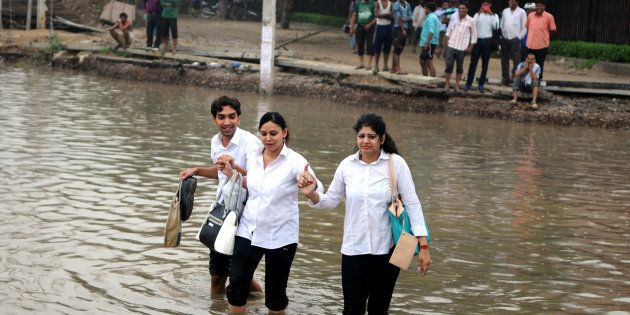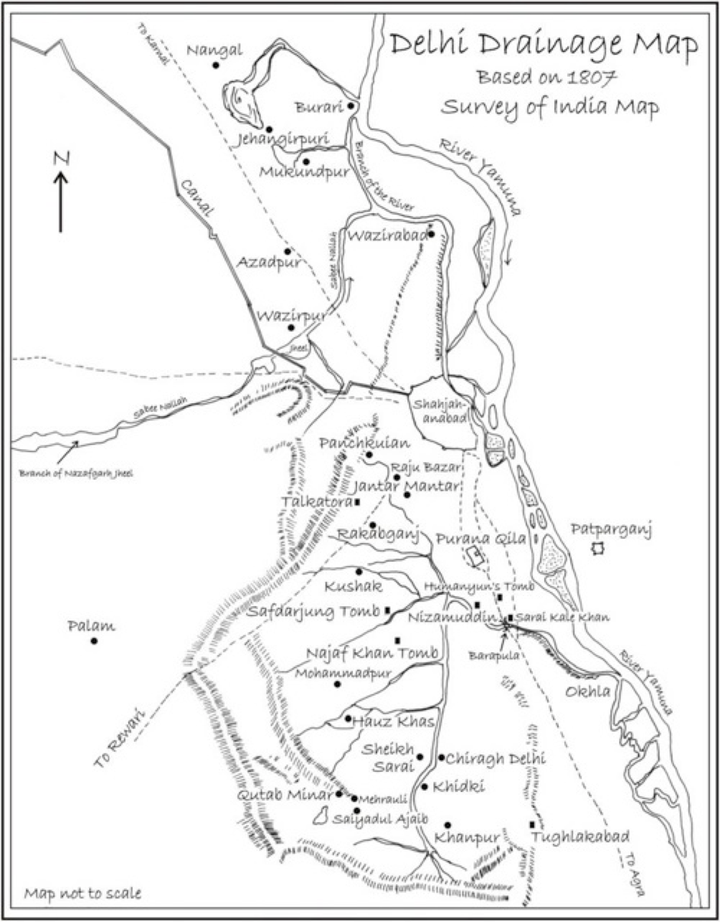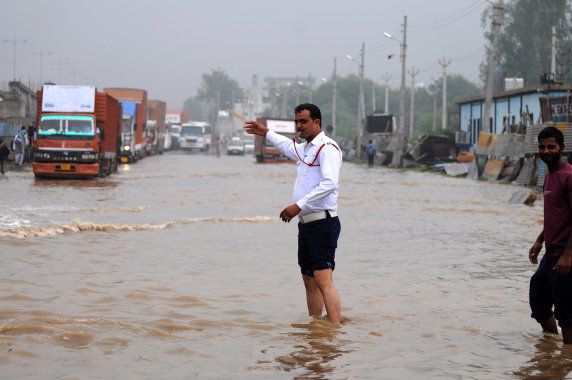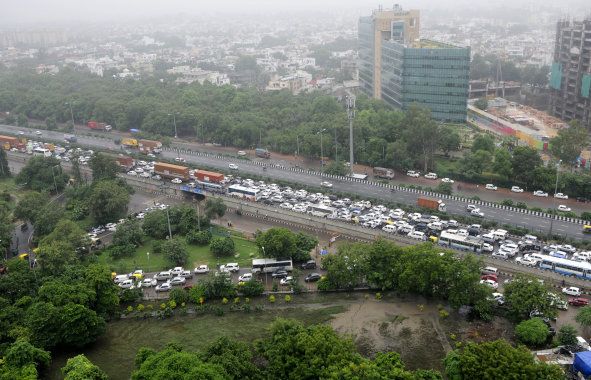
What happened in Gurgaon two days ago is only a foretaste of what is going to befall Delhi. The same fate awaits all other regions surrounding Delhi in the broader National Capital Region, if we refuse to draw appropriate lessons from the deluge that short-circuited the virtual dreams of those who had bought the chimera of the Millennium City.
A short recap of what led to the deluge will help place the entire issue in perspective. The low-lying plains of the area receive precipitation run-off from the Aravalis and the Chhattarpur area of Delhi. All this run-off used to flow through the Badshahpur Nala.
The nala would swell in the monsoons and have a full flow but the rest of the year it looked like a large open gully that was seen as a terrible waste of high-value real estate and so it was encroached upon. The encroachment could not have happened without the active connivance of those who were given the task of overseeing the planning of this dream city.

The problem was that those given the responsibility were petty men and they had their petty dreams and so land was encroached along NH8 and the natural channels of drainage were ignored. Builders created their own artificial drainage systems, overriding the natural patterns of drainage. Each builder lorded over his own dung heap and so you had mini drainage systems for each property. These mini systems did not talk to each other and they were not part of a larger pan-Gurgaon drainage plan. The natural drainage channels were filled, encroached upon, built over and in many places concretised.
All this violence was perpetrated on Gurgaon by people who either had no idea of the landscape and the larger picture of the terrain within which their mini-empires were rising, or they deliberately and wilfully ignored it.
In the short term you may escape these delinquencies against nature but sooner or later these felonies come back to haunt you and nature exacts a very heavy price when it begins to set them right. Invariably the perpetrators of the crimes are far away from Gurgaon now and that is why it is necessary to understand precisely what has happened in order to develop mechanisms that prevent a repetition of Gurgaon. What has happened in Gurgaon is only a microcosmic reproduction of what has been going on in Delhi and when it comes to a payback in Delhi the consequences will be devastating. So Gurgaon is a serious wake up call.
What happened in Gurgaon was only a reverse flow in the Badshahpur Nala for a few hours. The reverse flow happened because the channel of the Drain had been narrowed and in places it had been concretised. Whoever authorised the concretisation needs to be found and immediately placed behind bars before he inflicts greater damage on this land through his idiocies and greed. The same punishment needs to be reserved for those who initiated the covering up and concretising of the many drains in Delhi.
The so-called drains, or nalas, play a crucial role in the hydrology of the plains they drain. We call them drains, but they are in fact channels that carry the run-offs from the plains to streams and eventually to the rivers. In other words, what we treat as real estate going waste are in fact networks of tributaries to a vast riverine system that irrigates all the plains from Punjab to the Bay of Bengal and feeds us all.
When we encroach on the course of these tributaries or concretise their channels, we are preventing them from making the biggest contribution they make to the vast lands they criss-cross even as they drain excess water—they irrigate these lands. The water they carry in their narrow courses continues to seep into the earth and thus they work as aquifers, the more water they carry, the more they replenish the sub-soil water. The moment we concretise these channels, they cease to be aquifers and become inert carriers of water.

The constantly degrading quality of sub soil water in Gurgaon, in Delhi and in all of the NCR is a result of three interconnected factors:
1. Enormous quantities of water are being drawn through deep bore wells to meet the needs of the construction industry and this goes on unchecked, despite orders from superior courts. Clearly this cannot go on without the connivance of the powers that be.
2. More and more land is being built over or being covered in concrete, tarmac and pavement stones upon roads and foot paths. This prevents rain water from being absorbed into the soil and makes the replenishment of sub-soil water that much more difficult.
3. The natural drainage of the plains is being destroyed. Increasingly all rain water is being channelized into concretised storm water drains, systematically precluding any possibility of percolation of rainwater into the soil.
The more water we draw from the sub-soil, the deeper we need to go for more water and water extracted from such depths has a higher concentration of dissolved salts, contributing to higher degrees of chemical poisoning and serious health hazards. The flooding of the streets and the constant depletion of the sub soil are two sides of the same coin and no matter who tosses this coin it is never going to come heads up.
When we are through concretising all the storm water drains, have covered all the tributaries of the Yamuna and the Hindon and the other streams that feed the two and have built roads, car parks and Dilli Haats on top of all the nalas and when we have accomplished the task of concretising the beds of all the nalas, we will be ready to welcome a deluge that will wipe away all the memories of Gurgaon.

When the deluge happens—it is no longer a question of 'if it happens', because it will—it will not be one drain that will have a reverse flow. It might be all the drains together. (see map for the drains that flow through Delhi) It will happen on a day when Delhi receives 6 or 8 centimetres of rainfall within the span of a couple of hours. It will be a day when Haryana also receives a downpour and the Tajewala and Hathnikund barrages begin to overflow and Haryana has to release millions of cusecs of water to save her cities.
Environmentalists agree that such downpours and flooding is only going to increase in the wake of global warming. When this flooding and downpour comes visiting us the next time around, our drains will carry every drop that falls on the ground directly to the Yamuna because we would have by that time concretised all the land that can be concretised. The Yamuna will be in spate because of the waters from the upstream barrages and that is when the reverse flow will hit us. This is the scenario that we are assiduously working towards. All the drains will be on a reverse flow and the sewage system will pack up and there will be hell to pay.
This is not an alarmist view, neither is this an attempt to spread panic. It is merely a projection of a likely scenario based on a scaled up version of what has happened in Gurgaon. Gurgaon is a 20-year-old story. We have been doing this to Delhi for over a century. In Gurgaon it was only one drain, in Delhi we have a dozen major drains—the Chirgh Dilli, Sewa Nagar, IIT, Kushak, Najafgarh, Shahzada Bagh, Mayapuri and the Burari Nala are just a few of them.
All the drains will be on a reverse flow and the sewage system will pack up and there will be hell to pay.
Gurgaon still has open spaces and agricultural lands around it, where water could be drained or diverted into the natural drainage basins that surround Gurgaon, but Delhi has no such escape valves, Delhi is surrounded on all four sides by Delhi. There really are no escape routes.
All the land from the Aravalis in the South near Tughalabad to the Central Delhi ridge of the Arravalis tapers towards the Yamuna to the east while all the land to the east of the Yamuna in what is known as east Delhi, or Jamuna paar, tapers towards the Yamuna. The Yamuna flows through the lowest elevations in the Delhi plains, as do all rivers, and we have built extensively in the flood plains, in the lands that are the first to be flooded. This is a recipe for disaster. We can't blame anyone for it and we have to find our own solutions, because no gods can help us here.
The British, while building New Delhi, had rejected the area near the Kingsway camp and the plains of Burari because these areas were prone to floods, but we have in the last 65 years built in precisely the same areas—from Model Town to Okhla to the west of the Yamuna and from Sonia Vihar, Usmanpur, Yamuna Vihar, Gandhi Nagar, Geeta Colony and Shakarpur all the way to Chilla. Hundreds of settlements have come up in the high flood plains of the Yamuna. Many of these localities are placed right inside the low flood plains. A heavy downpour and a major release from Tajewala and Hathnikund Barrage and much of this will be under water, as it was in the 1980 floods of Delhi when even Jamna Bazar, large parts of ISBT Bela Road, behind IP College and Model Town were submerged.

A flood like the 1980 floods will certainly lead to reverse flow in many of the nalas now. Many of them have become narrower in the last 35 years. They have been encroached upon. At least one, across the Yamuna, has a large temple sitting right inside it. Many, like the Defence Colony Nala and the one that runs behind AIIMS and between Kidwai Nagar and South extension have had their beds concretised and then roofed over with pillars supporting roads on top. These covered drains are now death traps, no one will even know that there are obstructions or that there is a reverse flow. When eventually people find out it will be too late to do anything.
Is there an alternative path to this recipe for assured destruction?
Yes, there is, and the solution is rather simple. Most apparently complex problems have simple solutions. In this case all one needs to do is to undo the wrongs.
To begin with, all construction in the low-lying areas and the flood plains of the Yamuna has to stop. Unnecessary concretising, like the constant concretisation of pavements, has to stop. We need to prevent the flowing of untreated sewage into the nalas. This can be done by placing pipelines on both banks of each drain to trap all untreated sewage that flows directly into the nalas. A network of small sewage treatment plants at regular distances has to be built along the course of each drain, to ensure that only treated water flows in the channels of the drains. All concrete placed on the beds of the nalas has to be removed and all nalas that have been covered have to be opened, and roads built on them have to be dismantled. The moment we do this, the drains will have clean water flowing through them. They will once again become tributaries of the Yamuna and that is what they were intended to be. The drains will again become aquifers of Delhi and now clean water will seep into the soil. The quality of sub-soil water will gradually improve as will the level of sub-soil water. When all the drains carry clean water to the Yamuna, the Yamuna will clean itself. Delhi contributes 60% of all the pollution that the Yamuna carries. When this stops, the Yamuna will be reborn.
Is there an alternative path to this recipe for assured destruction?
The next thing to do is to build underground rain water harvesting systems. These have to be connected to the storm-water drains and will go a long way to replenish the sub soil water, this has the potential of saving thousands of million gallons of water that otherwise flows in a rush into the Yamuna and eventually into the ocean without being tapped at all.
In order to ensure that this scheme works, we need to educate the civic staff to not throw rubbish into the storm water drains, a practice that is uniformly followed through the length and breadth of the Indo Gangetic plains. If we can put in place these initial steps, we will postpone a recurrence of Gurujam indefinitely.
Good things don't come free and there is a cost to be paid for all this as well. The ban on buildings in the flood plains, though imposed by the superior courts, has never been seriously implemented. How else does one explain the Akshardham Temple? This was a precedent that allowed the Commonwealth Games Village to come up, allowing the flow of rather uncommon wealth into a few hands and also created the opportunity for a government agency to blatantly grab land and set up the Delhi Transport Corporation Millennium Depot. This shameless milking of the flood plains has to be stopped and this is the cost that has to be paid because this will create a serious land crunch. There is however a rather simple solution to this crisis as well. The Central and State Governments will need to work together on this. The DDA has to be prevented from auctioning lands to real estate honchos. The lands were acquired from the peasants of Delhi for building affordable housing for the residents of Delhi and that is what DDA should be doing, instead of selling land to real estate tycoons.
The solutions are easy, but they are far-reaching and drastic. But the mess we have created calls for drastic measures. Alternatively, we can wait for Gurujam revisiting us on a regular basis.